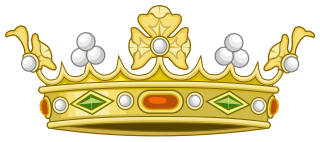Related Research Articles

Baron Hastings is a title that has been created three times. The first creation was in the Peerage of England in 1290, and is extant. The second creation was in the Peerage of England in 1299, and became extinct on the death of the first holder in c. 1314. The third creation was in the Peerage of England in 1461, and has been in abeyance since 1960.

Earl of Powis (Powys) is a title that has been created three times. The first creation came in the Peerage of England in 1674 in favour of William Herbert, 3rd Baron Powis, a descendant of William Herbert, 1st Earl of Pembroke. In 1687, he was further honoured when he was made Marquess of Powis.

Lord Nairne is a title in the Peerage of Scotland, created by Charles II for Sir Robert Nairne of Strathord in 1681, which since 1995 is held by the Viscount Mersey.

Thomas Philip de Grey, 2nd Earl de Grey, 3rd Baron Grantham, 6th Baron Lucas, KG, PC, FRS, styled as The Hon. Thomas Robinson until 1786 and as Lord Grantham from 1786 to 1833, of Wrest Park in the parish of Silsoe, Bedfordshire, was a British Tory statesman. He changed his surname to Weddell in 1803 and to de Grey in 1833.

Charlotte Elizabeth Cavendish, Marchioness of Hartington, 6th Baroness Clifford was the daughter of Richard Boyle, 3rd Earl of Burlington and Lady Dorothy Savile. From 1748 until her death she was married to William Cavendish, Marquess of Hartington, later the 4th Duke of Devonshire and Prime Minister of Great Britain.
Marquess or Marchioness of Galatone was a noble title created by the Kings of Spain for Stefano Squarciafico, Patrician of Genoa, on 29 June 1562, and inherited according to Spanish nobiliary law. The title is currently held by the Prince or Princess Belmonte.
Charlotte Townshend, Viscountess Townshend, suo jure16th Baroness Ferrers of Chartley and 7th Baroness Compton, known as Lady Charlotte Compton until 1749 and as Lady Ferrers of Chartley from 1749 to 1764, was a British peeress.

Marquess of San Felipe, is a hereditary title in the Peerage of Spain and Peerage of Sardinia, granted in 1709 by Philip V to Vicente Bacallar y Sanna, a Sardinian historian of Valencian origin who served as ambassador in the Spanish Netherlands and the Republic of Genoa
Marquis of Villahermosa e Santa Croce is a title first granted in 1745 by Charles Emmanuel III, king of Sardinia to the Sardinian merchant Bernardino Antonio Genovès. It has passed afterwards to a branch of the house Manca, called Manca di Villahermosa since.
Marquis of Neoneli is a title granted in 1774 by Victor Amadeus III of Savoy, king of Sardinia, to Sardinian nobleman Pedro Ripoll. It has passed afterwards to the house Sanjust.
Marquis of San Sperate is a title granted in 1749 by Charles Emmanuel III of Savoy, king of Sardinia, to Sardinian judge and nobleman Joseph Cadello. It has passed afterwards to the house Ripoll and eventually to Sanjusts.
Marquis of Montemuros, also called Monte Muros, is a title granted in 1762 by Charles Emmanuel III of Savoy, king of Sardinia, to Sardinian nobleman and lord Pedro Martinez. It got extinguished in 1918.
Marquess of Soleminis is a title granted in 1651 by Philip IV, king of Spain and king of Sardinia, to the Sardinian nobleman Francisco Angel Vico Sonza. It has passed afterwards to the house Amat.

The Marquessate of Groppoli, in Tuscany and Liguria, was ruled by the House of Brignole-Sale, an illustrious patrician family of Genoa who were its sovereigns from 1592 to 1774.

Mary Hill, Marchioness of Downshire and suo jure1st Baroness Sandys, was a British peeress.

Elisabeth van den Eynde, Princess of Belvedere and suo jure Baroness of Gallicchio and Missanello was an Italian noblewoman. She was the consort of Carlo Carafa, 3rd Prince of Belvedere, 6th Marquess of Anzi, and Lord of Trivigno, and the daughter of Ferdinand van den Eynde, 1st Marquess of Castelnuovo and Olimpia Piccolomini, of the House of Piccolomini. Her grandfather was Jan van den Eynde, a wealthy Flemish merchant, banker and art collector who purchased and renovated the Palazzo Zevallos Stigliano in 1653. Her father Ferdinand, the Marquess of Castelnuovo, built the Vandeneynden Palace of Belvedere between 1671 and 1673. While the Palazzo Zevallos in central Naples passed to her elder sister Giovanna, who married a Colonna heir, Elisabeth was given the monumental Palazzo Vandeneynden, alongside a smaller portion of the Marquess' assets, which included his art collection, one of the largest and most valuable in Naples and its surroundings. Upon her marriage to Carlo Carafa, the Vandeneynden Palace came to be known as Villa Carafa.
Duke of Vallombrosa was a title created for the House of Manca. The present holder is disputed.
Bertha Lelgarde Clifton, 22nd Baroness Grey de Ruthyn was a British aristocrat.